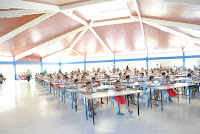Bits ‘n’ Pieces: Communication
License plates. They have a system for license plates. What a concept! A rental car plate has an R, and a taxi has a T (very handy because taxis are mostly privately owned and there’s nothing on the vehicle to tell you it’s a taxi). If it’s a Ministry vehicle, there’s a P (for Portungaue), and a rental car has an R.All privately owned cars have a C, leased cars, an L, and pick ups and vans, a J. Prime Minister cars have a PM. There are even a few personal vanity plates around.
Language double-takes. A lot of the time when I’m in a meeting or others are talking in Tongan, I kind of zone out because I understand so little. Then they’ll pop in with an English phrase like “minimum requirements” and my mind wakes up. There are just some ideas and phrases that haven’t made it into Tongan easily.
One day I was walking home from work past the primary school, and the children were all around getting picked up at the end of the day. All of a sudden I heard “I’m riding shotgun. I called it.” What? No, I must have misheard. But then I heard it again. Talk about a mental double-take, and wondering how that phrase made it to Tonga and out of the mouth of a child.
A co-worker recently told me they just keep it “easy-peasy.” That gave me a mental smile. It’s so much fun to be taken off-guard by unexpected language.
Hopa bananas. A co-worker gave me a hopa banana to eat, and gave me a Tongan story, too. “Why the seeds of the hopa banana look like ants.” First, let me tell you about the hopa. It's much more squared-off and rectangular than the bananas we have in the U.S. It doesn't have the banana “smile” shape, either. It has a line of big black seeds all down the center.
One day a rat was chasing a group of ants, and, of course, they were anxious to find someplace to hide and get away from the rat. Finally, they saw a hopa banana up ahead and they quickly ran inside, all in a row, and waited for the rat to run on by. The rat, however, saw where they went. Since he couldn't get at them in the banana, he decided to teach them a lesson and he closed up the end where they ran in and they couldn't get out. That's why hopa bananas have a long line of large black seeds all down the middle of the fruit.
As I ate the banana, I have to admit it was hard not to think of those big black seeds as ants. Somehow, though, I managed it, and the banana was tasty! The story definitely added to my enjoyment of the fruit.
Eyebrow talk. Why talk when a flick up of the eyebrows can say so much? I think people's faces here are so expressive. Where we might say “sure” or “ok”, etc. to show the speaker we are listening or in agreement, or even doubt them, here it's the way you raise your eyebrows. And the message gets across! I've been practicing....
A photo is worth.... Couldn't leave a blog without a picture, especially one titled "communication."
A photo is worth.... Couldn't leave a blog without a picture, especially one titled "communication."
 |
| I'll explain this when I write soon about sharing. See if you can guess! |














